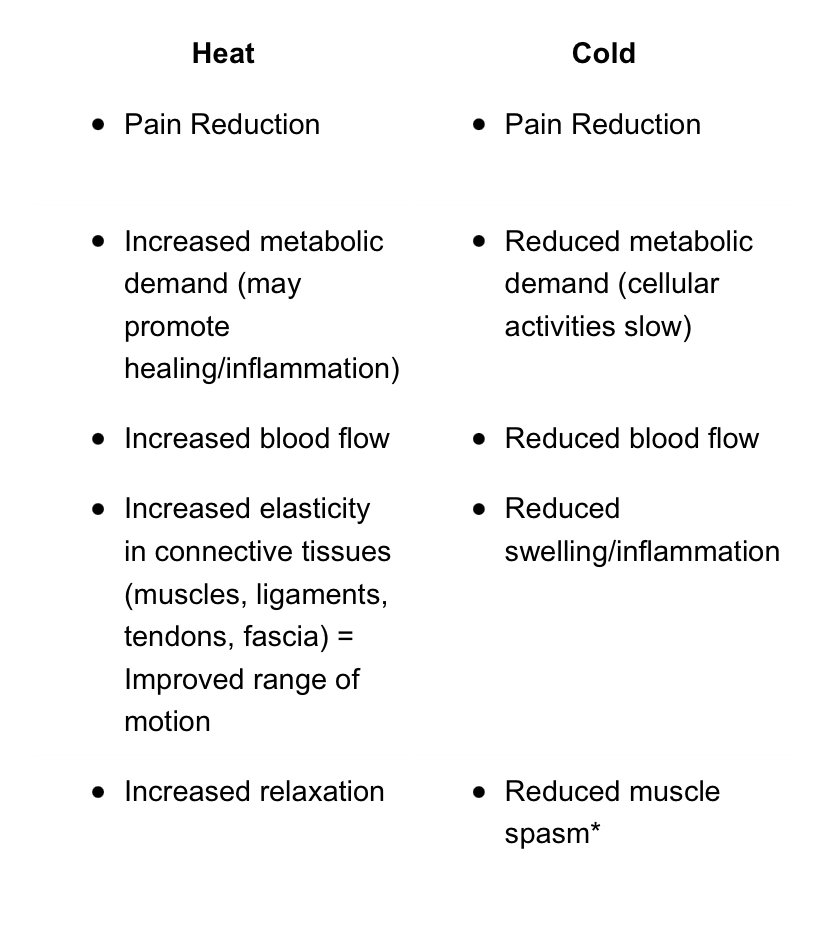Written by Marissa Hoen | January 26 2022
Yesterday I woke up a bit stiffer than usual, some of my muscles still feeling the tension of the workout from the day before. I stood up and quickly stretched when suddenly I felt it- a twinge of pain from a muscle in my low back (the QL to be specific!). The pain was sharp, intense, and left my oversensitive muscle in great tension. At this moment I was experiencing two types of muscle pain: pain caused by a low back muscular strain, and DOMS (delayed-onset muscle soreness) from my workout the day before.
I was in pain but not quite ready to take medications, and wanted to use heat or cold to help the pain and hopefully help with healing. My instinct was to reach for the heating pad, which did help to decrease the pain for a bit- but let’s take a look at what the research recommends!
HEAT vs COLD: what are the effects on the body?
(Malanga, Yan, & Stark, 2015)
*Note muscle spasms are not reduced in all individuals who use cold therapies.
Heat VS Cold: which is better at pain relief?
The jury is still not out on this one! Authors on this topic point to the need for more high quality studies as the evidence is not convincing enough one way or the other! (Wang et al, 2021; Malanga, Yan, & Stark, 2015). Even though we can’t yet claim cold is ‘better’ than heat (or vice versa), I can get behind this general rule that Malanga, Yan, & Stark suggest in their paper:
The classic method of icing an acute muscular injury has been consistently shown to reduce pain, and may be a better choice in the first 2-3 days of injury as heat can increase heat and swelling in the area. 72 hours after injury, cold therapies may not be as beneficial.
Takeaways:
What do these somewhat inconclusive studies tell us? First we need more studies on the topic to find which method works better. But in the meantime- we need to figure it out for ourselves! Personally, I love using alternating heat and cold for my sore or strained muscles. If you have a condition that has altered the sensation of your skin, use an extra layer over the heat or cold application to avoid burning or freezing your tissue!
Quick note about material flow:
If I had moved more slowly into the stretch in the morning, I could have avoided that muscle strain. Muscles, tendons, ligaments, bones are all made of both a water component and material components. When moving quickly, the water doesn’t have enough time to flow in the tissue, so the stiffer the tissue (in this case muscle) will be. When we move more slowly, we allow time for flow and the muscle is more pliable. So especially when you wake up, take time to move a bit more slowly to allow muscles to warm up and hopefully you can avoid this injury!
References
Malanga, G. A., Yan, N., & Stark, J. (2015). Mechanisms and efficacy of heat and cold therapies for musculoskeletal injury. Postgraduate Medicine, 127(1), 57-65. https://doi.org/10.1080/00325481.2015.992719
Wang, Y., Li, S., Zhang, Y., Chen, Y., Yan, F., Han, L., & Ma, Y. (2021). Heat and cold therapy reduce pain in patients with delayed onset muscle soreness: A systematic review and meta-analysis of 32 randomized controlled trials. Physical Therapy in Sport, 48, 177-187. https://doi.org/10.1016/j.ptsp.2021.01.004
Image credit: https://www.livingcentreclinic.com/pain-relief-choosing-hot-or-cold/


